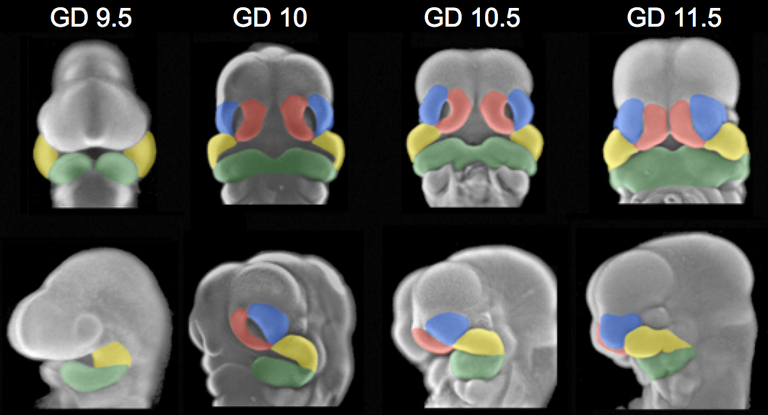- Robert M. Greene, PhD
Scholarly Activities
A quarter of a million babies—3% of all infants born in the US each year— have some mental or physical defect that is evident at birth. Since the causes of nearly all birth defects are largely unknown, research into molecular regulatory mechanisms responsible for normal embryogenesis provides the framework for investigations into the etiology of abnormal embryonic development.
Craniofacial malformations occur with a frequency of 1 in 600 live births annually in the United States. Our previous studies have provided substantial evidence supporting the premise that various cellular signal transduction pathways interact to regulate cell proliferation and cell differentiation in embryonic craniofacial tissue. Such interactions represent the underpinnings of a complex and delicately balanced developmental system where morphogenesis and cellular differentiation of the craniofacial region are mediated by the sequential expression of molecular signals. Our studies dealing with molecular analyses of gene function in the embryo—utilizing the developing craniofacial region—are designed to provide definition and clarification of developmental signaling pathways critical for normal embryogenesis as well as identification of foci for perturbation and attendant fetal abnormalities.
Current studies—selected specifics outlined briefly below—are designed to identify means by which signal transduction pathways, known to be critical in development of the craniofacial region, regulate gene expression and embryonic development.
Overview of selected laboratory investigatory areas:
1 - microRNAs & epigenetic regulation of craniofacial development
2 - Transcriptional coactivators and craniofacial & neural tube development.
3 - Cigarette smoke-induced adverse developmental outcomes.
4 - TGFß/Smad signaling mechanisms in embryonic craniofacial development.
Peer-Reviewed Publications (2016-2019)
- Greene RM, Pisano MP, Warner D. Genetic and Epigenetic Perspectives of Orofacial Clefting. In: Comprehensive Cleft Care, 2nd edition. (editors: Losee JE, Kirschner RE), CRC Press, Chapter 10, pp 185-205 (2016).
- Warner D, Smith S, Smolenkova I, Pisano MM, and Greene RM. Inhibition of p300 histone acetyltransferase activity in palate mesenchyme cells attenuates Wnt signaling via aberrant E-cadherin expression. Exp Cell Res 342:32-8 (2016). PMCID: PMC4818121
- Neal RE, Jagadapillai R, Chen J, Webb C, Stocke K, Greene RM, Pisano MM. Developmental cigarette smoke exposure II: Hippocampus proteome and metabolome profiles in adult offspring. Reprod Toxicology ( 65:436-447 (2016). PubMed PMID: 27208486.
- Neal RE, Jagadapillai R, Chen J, Webb C, Stocke K, Stocke K, Gambrell C, Greene RM, Pisano MM. Developmental cigarette smoke exposure II: Kidney proteome profile alterations in 6 month old adult offspring. Reprod Toxicology 65:425-435 (2016). PMID: 27208485
– Neal RE, Chen J, Webb C, Stocke K, Gambrell C, Greene RM, Pisano MM. Developmental cigarette smoke exposure II: Hepatic proteome profiles in 6 month old adult offspring. Reprod Toxicology 65:414-424 (2016). PMID: 27319396
- Mukhopadhyay P, Seelan R, Rezzoug F, Warner D, Brock G, Smolenkova I, Pisano MM, Greene RM. Determinants of orofacial clefting I: Effects of 5-aza-2/-deoxycytidine on cellular processes and gene expression during development of the first branchial arch. Reprod Toxicology 67: 85-99 (2017). PMID: 27915011
– Seelan R, Mukhopadhyay P, Warner D, Smolenkova I, Pisano MM, Greene RM. Determinants of orofacial clefting II: Effects of 5-Aza-2’-deoxycytidine on gene methylation in the first branchial arch. Reprod Toxicology 67:100-110 (2017). PMID: 27923600
– Greene RM and Pisano MM. Serotonin signaling as a target for craniofacial embryotoxicity. In: Handbook of Developmental Neurotoxicology, 2nd edition, (editors: Paule M, Wang C and Slikker W), Elsevier Press, Chapt. 6, pp. 65-74 (2018).
– Greene RM and Pisano MM. How Has Epigenetics Influenced Understanding of Teratogenesis? In: Teratology Primer, 3rd edition. (editors: Hales B, Scialli A, and Tassinari MS), Teratology Society (http://teratology.org/primer/Epigenetics-teratogenesis.asp) (2018).
– Seelan R, Mukhopadhyay P, Pisano MM and Greene RM. The effects of 5-2’-Deoxycytidine (Decitabine) on gene expression. Drug Metabolism Reviews 50:193-207 (2018). PMID: 29455551
- Mukhopadhyay P, Warner D, Smolenkova I, Pisano M, Greene R. Spatio-temporal expression and functional analysis of miR-206 in developing orofacial tissue. MicroRNA 8:43-60 (2019). PMID:30068287
- Greene RM, Smolenkova I and Pisano MM. Laser capture isolation of murine embryonic neural crest cells in: Methods in Molecular Biology, Protocols; (ed. Schwarz, Wisniak), Springer International Publishing AG, New York (in press) (2019).
- Mukhopadhyay P, Seelan R, Webb C, Greene RM, Pisano MM. Impact of prenatal sodium arsenate exposure on gene expression in a pure population of migratory cranial neural crest cells. Reprod Tox 86:76-85 (2019).
– Greene RM and Pisano MM. Electronic cigarette use and pregnancy. Birth Defects Research (Special Issue; invited review) (in press) (2019).

Imaging of frontal (top panels) and lateral (bottom panels) views of gestational days 9.5 and 11.5 murine embryonic facial structures. The first branchial arch consists of a smaller maxillary process (yellow) and a larger mandibular process (green). Medial nasal processes (red); Lateral nasal processes (blue).
